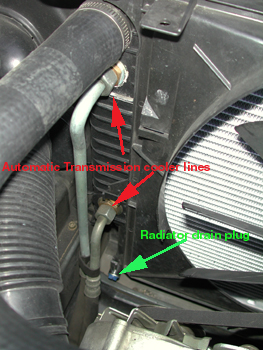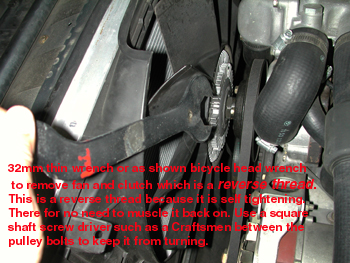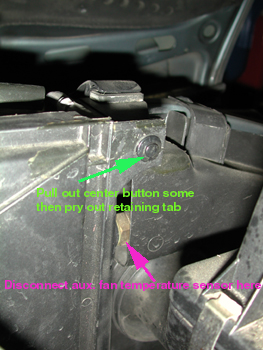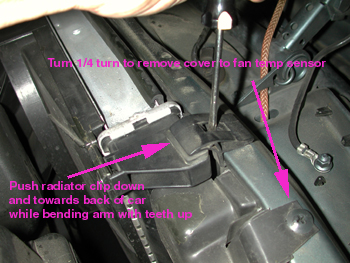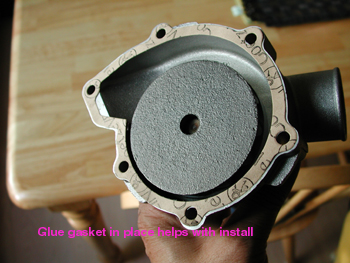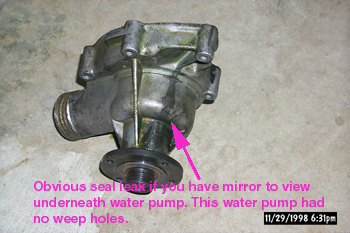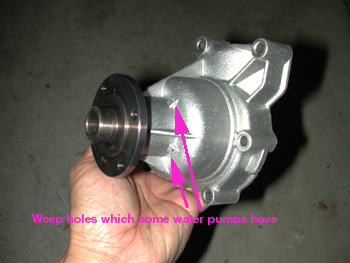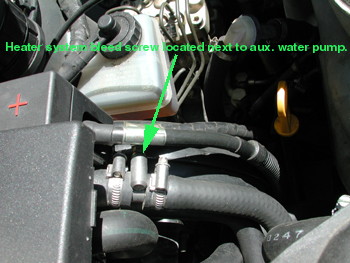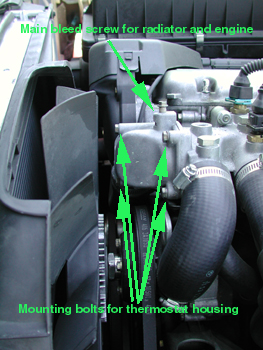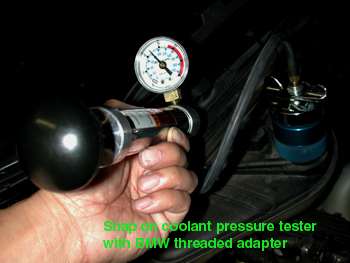Article by: Winston Fong
Article applies to: all models with the M30 engine.
Start by removing under panel from underneath the car and below radiator which is attached to body by four plastic nuts (looks like plastic skid plate).
Once the panel is removed you can drain the radiator by removing drain plug at lower left of radiator.
Or leave panel on and make a small mess.
You should also drain the engine block which carries half the coolant by removing the 19mm plug under cylinder number 6 on the right side.
Watch out it is in a precarious and hard to see place and coolant will splash all over.
Remove the fan and its clutch which is a reverse thread with a 32mm thin wrench or bicycle head wrench.
Below: Disconnect the upper and lower coolant hoses by twisting and pushing towards the radiator to break them loose.
To remove fan shroud, pull the center button of the radiator shroud mounting tabs out some then pry out tabs.
Remove the cover on the right headlights and disconnect the aux. fan temperature sensor.
I don’t know how to explain it since the first time I removed the radiator mounting tabs it was easy and the second time I busted the tab.
Seems you need to pry the toothed arm up with a small screwdriver while pushing down and towards the back of the car with your other hand to release it from under the radiator support.
Disconnect the automatic transmission coolant lines last and lift the radiator out.
Remove the four bolts holding pulley to water pump, remove the six water pump mounting bolts and wiggle the water pump up and down it should come off.
Scrape the old gasket off and your ready to install new water pump. If you want now’s the time to replace your thermostat.
My opinion on thermostats is run a 71c thermostat if your driving more than 20 minutes (Especially if it’s highway driving) each time your starting your car and don’t live in cold climate.
This is especially true if you have an automatic transmission since heat is its worst enemy.
Cooler ATF fluid will lead to longer tranny life. Manufactures run hot thermostats to get the absolute lowest emissions during EPA emissions test.
But really emissions difference with 71c and 80c thermostat is very small so small I find a bigger effect from having old spark plugs in place.
Does the 71c thermostat cause the cold start to be on all the time? No it’s not true I run them in three of my Bimmers with no problem.
Cold start should be shut off long before this temperature. I find it just puts less stress on the cooling system and automatic transmission.
Squeeze the upper hose of a 80c system at operating temperature, if you can it’s usually rock hard.
Now squeeze a 71c system its some what softer since the operating pressure is lower.
Putting less stress on the radiator, heater core, and hoses. I change my oil every 4,000 miles so condensation in the oil hasn’t been a problem anyway.
Changing the coolant every two years will lead to a long life with your Bimmer radiator.
Changing coolant every 2 years has gotten me to 241,000 miles on my original radiator of my 735i.
Which still runs cool on a 100 degree day and doesn’t leak. I also have other Bimmers and cars with over 150,000 miles on the radiators.
Unfortunately I bought this 535i and the owner maintained everything well except for the coolant which wasn’t changed for 5-6 years.
Even though he had only 76,000 miles on it rust kept coming out as I flushed the system with a hose.
Finally I gave up and decided to change the radiator.
Here are my thoughts on testing coolant and BMW vs Cheaper coolants.
I’ve seen Bimmer water pumps with 1 or 2 weep holes and some without weep holes.
It doesn’t matter but is good to know when your looking for leaks so you don’t miss checking one.
Once you’ve bolted the new water pump and pulley back in place, reinstall the new or old radiator and its connections.
Refill with 50/50 mix of coolant and distilled water after opening the two bleed screws.
If the engine block was drained it should take about 2 gallons after bleeding.
If it takes only 1 gallon you have a major air pocket and will have to bleed more at both bleed screws.
I know bleeding has been a pain for some people but I’ve never had a bleeding problem and I’ve done it at least 2-3 dozen times or more with absolutely no problems.
If no coolant comes out of the thermostat bleed screw, remove it and run a wire through the opening till air or fluid comes out while filling.
Sometimes you will hear air gurgling but nothing comes out the bleed screw.
In that case if you cleared it with a wire you can try blowing through the coolant reservoir tank (sounds sick but works) or if you have a coolant pressure tester use that (not so gross).
Some people have reported better bleeding result if the front of the car is in an incline.
Pressure tester is a must have if your planning on working on your cars for the next twenty years or so.
You can test for leaks (especially nice because you can check while the system is cold and make repairs while it’s not hot).
Empty the coolant system in a minute by pressurizing the system, check radiator caps, bleed air out, etc.
If you’re checking a Bimmer radiator using a pressure tester do it while hot sometimes the rubber tank gasket will leak when cold but not hot.
Once you’ve gotten all the air out start it up with the heater on and let it reach operating temperature, add fluid as needed and your done.
Keep it running cool!

